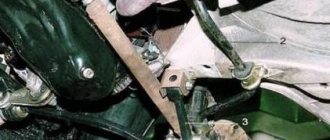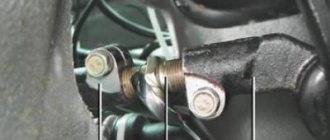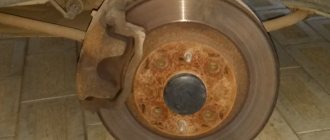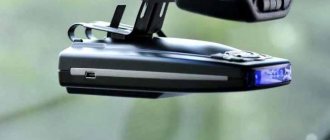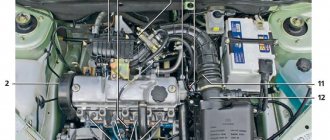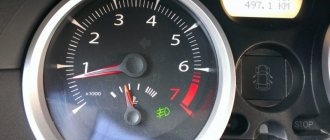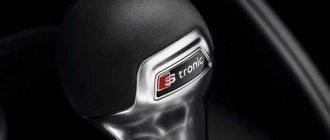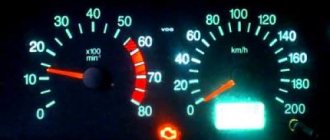One of the most advanced devices available today to the domestic traffic police is the “Strelka” (radar). For many people who do not understand such equipment, this device is better known as the “Arrow”. Until recently, it was customary to use such equipment exclusively in the field of military aviation, where it was used for high-speed, and at the same time absolutely invisible interception of targets, since no anti-radar detector could detect it.
Today, “Strelka” (radar) is actively used by modern traffic police and traffic police officers, and in some cases it can even be found among patrol officers who need to quickly detect an intruder at a fairly large distance.
How does such a device work?
The most modern police complex with the abbreviation KKDDAS is equipped with a specialized video recording camera, with which you can monitor violations that occur within a radius of up to a kilometer. This happens when the driver does not have the opportunity to see where the “Arrow” (radar) is located, as a result of which he is not able to get rid of responsibility for the violation. Of course, the only choice in this case is to simply avoid the possibility of violation.
Alerts
They are very flexible and differ slightly between the Android and iOS versions. Both platforms have different voice alerts for each type of danger, a customizable sound signal (beeper), and vibration. You can set up a triple alert as you approach the next unpleasant camera - first a couple of kilometers away, then a kilometer away, and a third - in close proximity.
Android users, in addition to this, receive a visual widget, as well as a pop-up visual notification that appears on the screen on top of any running program, including the navigator - the tools will not interfere with each other’s work. iOS, due to its limitations, cannot do this, and therefore only a static screen is available there indicating the type of danger and the distance to it.
Both versions of the application work perfectly in the background.
Cheaply avoiding the radar
There are a fairly large number of options on how to properly protect yourself from being detected by Strelka (radar). Of course, such methods vary in terms of financial investment, but the simplest and cheapest is to use a specialized film on license plates, with the help of which one or two letters of the number are duplicated, as a result of which they become invisible. Functionally, this is possible through the use of a specialized polymer coating with a light filter that allows you to distort the black digits of the license plate, making them unreadable. This way, you eliminate the risk of being recorded by the Strelka radar simply because it will only see about half of the symbols and numbers present in your number.
Considering how quickly traffic fines have been rising lately, and how expensive truly powerful radar detectors are, the cost of using film is simply minimal.
What types of radars are there?
The notorious Strelka is not the only type of equipment used. Currently, Russian traffic police use the following main systems:
Merlin
1.) Gyrfalcon. Its small size allows it to be hidden from drivers, and the device has stationary and mobile options. It can even detect overtaking in areas prohibited for this maneuver.
Cordon
2.) Cordon. The triple emitter even adjusts to road markings and the road surface, which makes it possible to react to lane crossings or pulling off to the side of the road.
Rapier-1
3.) Rapier-1. It is somewhat similar to a surveillance camera, which lulls the vigilance of drivers. The armored body protects it from vandalism.
Robot
4.) Robot. It resembles a switching box, so motorists for a long time cannot understand where the fixation comes from. It has a round frequency emitter and a lens.
Scat
5.) Scat. It looks like a birdhouse, and under the tripod there is a powerful self-powered battery. Usually they try to use it in warm weather, otherwise the charge quickly sags. There is also a stationary version mounted on poles.
Arena C
6.) Arena S. A device very similar to an arrow that gives all-round detection. In frosty weather it can malfunction, so it is gradually abandoned.
PKS-4
7.) PKS-4. This is a complex device, which is a stationary post with a powerful computer on board. Any computing system that increases accuracy can be connected to it.
CRIS-P
8.) CHRIS-P. It is installed on a tripod on the side of the road, automatically aligned with the horizon, and then begins its work. Outwardly, it resembles a video camera used by reporters.
These types of radars are not the only ones in the arsenal of the traffic police. Each variety considered is a hybrid of an emitter and a camera. They include a photo part when a moving object exceeds the speed limit. The fixation range for all models is in the range of 200-400m, and their range coincides with the arrow. Also, almost all of them can notice violations of road markings and the order of movement on secondary and main roads.
Strelka features
It is worth noting the fact that with the help of an automated stationary device, unlike the vast majority of other devices, it is not a specific vehicle that is tracked, but the entire traffic flow at once, thus ensuring the simultaneous processing of a section of the roadway at a distance of up to a kilometer around the place where there is a “Strelka” radar (the photo above will tell you what it is). And these are just a few of the advantages that distinguish such a modern set of equipment.
The principle of operation of the radar detector against Strelka
Firstly, it’s worth pointing out right away that radar detectors against Strelka (as well as against any other radar), which are often confused with radar detectors, are prohibited both in Russia and Ukraine, and in most countries of the world . Read more about how a radar detector differs from a radar detector here.
Well, as for specifically radar detectors against Strelka, today they can all be divided into 2 groups .
The first includes detectors with an integrated GPS module and a database of the location of all known stationary Strelka-ST complexes . Such a device determines the location of the car and, when approaching the radar complex, warns the driver in advance about the need to reduce speed. But, although the database is updated quite often, the GPS module is still powerless against the mobile version of Strelka.
The second group is detectors with an innovative high-tech module designed specifically to capture short-pulse signals from Strelka . An expensive platform and an enlarged horn antenna make it possible to find Strelka even when it is 2 kilometers away on the highway and up to 1 kilometer in the city.
Such detectors have a number of advantages over detectors with built-in GPS and, first of all, the ability to detect the STRELKA-01-SM mobile radar.
In addition, there is no need to constantly maintain the software and update the database. Also, such detectors do not trigger on temporarily disabled Strelka-01-ST complexes.
How does such a radar work?
This equipment constantly emits pulses that gradually spread along the road surface. The signal, which is reflected from cars within a radius of about 1000 m, returns to the fast conversion block, where data regarding the speed, as well as the range of this vehicle from the place where the Strelka radar is located, begins to be formed (what this is, the photo above shows in all variants execution).
At the same time, using a digital television camera, a separate signal is transmitted to a specialized image recognition program, as a result of which the Strelka video recorder-radar identifies all moving cars, clarifies their coordinates, calculates the trajectory of movement, and then accurately determines the speed of movement.
Information from the radar and analyzer is subsequently transferred to a specialized cross-correlation program, through which the correlation of indicators is carried out and the determination of a speeding vehicle is carried out. If such a vehicle approaches the radar at a distance of less than 50 meters, the Strelka radar signal is triggered, activating the function of photographing the intruder.
It is worth noting the fact that with the help of such a complex the situation is analyzed in detail regardless of the current weather conditions (it is worth noting only the temperature range, which ranges from +60 °C to -40 °C, as well as the ability to work at 98% air humidity). Among other things, the equipment is sufficiently protected from various mechanical shocks, as it is manufactured in a specialized anti-vandal housing.
Choosing a radar detector versus Strelka - a short test review
We have selected the most interesting radar detector models for 2014. The most popular of them are presented below.
Cobra RU 955ST (price 230$)
According to the stated characteristics, this radar detector detects Strelka at a distance of 2200 m, while giving the driver an increasing signal when approaching it. In addition, the Cobra RU 955ST also detects the Ka band, which is not yet very used, but promising in Russia, as well as the Ku band, which is popular in Europe, not to mention the usual X and K. The detector also copes well with laser radars.
Reviews of the Cobra RU 955ST radar detector
Leonid, 26 years old, Krasnodar
Pros : today was the first day I used it. I discovered radars where I didn’t think there were any. I didn't find any arrows, but I found all the lasers. Cons : sometimes he claims to have found the K range where it cannot exist. But it shows the first stage, not higher. I think there's some kind of interference. It can be treated by turning on the city mode. In general, the thing is useful, I don’t regret the money spent.
Peter, 52 years old, Moscow
Pros : An excellent detector, it reacts to the arrow as it should - 100-200 meters before the radar begins to see the car. There are no unnecessary settings - city 1/2/3 or highway 1/2/3. When the “City” mode is turned on, the sensitivity to the arrow does not decrease. False positives are at a minimum. I thought the price was too high until I took it apart and looked at the insides - everything was done very well. I was amazed by the number of electronic components - I got the impression that I had purchased some kind of super-futuristic thing. Cons : the suction cups are not very good, you need to get used to them to install them. You need to get used to the original principle of working on camera.
Street Strom STR-9540EX (price $280)
Unlike the previous model, this radar detector has a built-in GPS module. Thanks to the “Strelka-Geiger” mode, the approximate distance to the stationary radar is displayed on the detector screen. It also copes well with pulse modes X and K, and sees laser radars. Picks up signals from Strelka, Robot and other modern speed meters.
Reviews of the radar detector Street Strom STR-9540EX
Mikhail, 28 years old, St. Petersburg
Pros : modern, comfortable, ergonomic design. In the city he can see the arrow 300 m away without GPS, 600-700 m with GPS, on the highway - about 1 km with GPS. There are a minimum of fakes; in city 1 mode there are none at all. I would say the best radar detector in its price range. Cons : I didn’t find any after 2.5 months of use
Timofey, 26 years old, Naberezhnye Chelny
Pros : finds everything I know and don’t know. False ones do happen, but rarely, and even after turning on the mode, city 1 yells only when really necessary. With GPS it is convenient to drive through unfamiliar areas, especially where Gyrfalcons and Odysseys operate. Convenient customizable parameters, you can turn off unnecessary ranges. There is a customizable speed limiter. Updating the software and database is very easy. Cons : sometimes freezes - about once every 4 months. The GPS database is not always up to date, although it is updated once a month
SHO-ME G-800 (price $140)
The detector effectively detects all known ranges. There is a three-level filter with “Highway”, “City” and “Auto” modes. High sensitivity allows you to actually catch Strelka at a distance of 1200 m. There is a USB port and a GPS module.
Reviews of the SHO-ME G-800 radar detector
Alexander, 26 years old, Odessa
Pros : an indisputable advantage is the price/quality ratio. Compact body, high build quality, ease of use. Speed, radar radiation level, time are displayed on the screen. The presence of GPS is, of course, VERY convenient, especially since the manufacturer adds new locations of radars and complexes every week. If the speed is not exceeded, the detector is completely silent, only messages appear on the display. Finds the arrow clearly. I checked it specifically: I turned off the GPS - the detector reliably caught the arrow signals 1100 m away. Cons : when driving slowly, the GPS speed is determined with a delay. It is not clear why a compass needle is needed.
What are its advantages?
Today, the Strelka radar is recognized as one of the most advanced devices in the traffic police. We have already figured out how this device works, now let’s look at its main advantages:
- violations are recognized at a distance of up to 1000 meters, which is very, very impressive when compared with similar equipment;
- speed can be measured at a minimum range of 50 meters, with accuracy reaching 2 km/h;
- a fairly wide range of speeds is recognized (up to 180 km/h);
- the camera is used to record video of the vehicle while driving, and the quality of such video is 12 frames per second;
- in automatic mode, those objects are highlighted whose movement occurs with certain violations;
- A command is fully automatically issued to detect and further recognize the vehicle license plate in accordance with the video material if the intruder has approached closer than 50 meters.
News
Date: 2013-02-26Over the past couple of years, Moscow, together with the Moscow region, has noticeably increased the number of various equipment for monitoring traffic violations. New products in the field of traffic monitoring have been added to the number of installed fixed systems and hand-held radars for speed measurement. This equipment will most likely soon replace outdated tracking systems, as it is distinguished by impartial control over the section of road under its control and the speed of transport.
Yes, and such new equipment does not please car enthusiasts at all, because it turns out that now even the best radar detectors will not be able to one hundred percent help speed enthusiasts from fines and tickets. And this headache is in the photo. The name of this radio speed controller is ARROW. It has two configurations: mobile (STRELKA-M) and stationary (STRELKA-ST).
Depending on the territory in which it is installed and the goals pursued, as well as on the set parameters (installation angle, range, clarity), STRELKA can control the speed limit in the range of 10 meters - 1 kilometer. On different landscapes, the tasks it solves vary somewhat.
Roads with a speed limit of up to 90 km/h (they fall under the definition of average speed). These are highways with one, maximum two lanes, with a variety of uneven terrain. There are many populated areas in such areas, and that is why very often there are speed limits in a huge number of areas.
In such places, the stationary type ARROW is installed at the most obtuse angle to the road with a slope towards the highway, and the following parameters are configured:
• control of the primary speed mode in the range of 350-400m
• final speed control from 25 to 50 m
• registration of GRZ by optics at an estimated distance of 25-50 m.
As of August 2012, during testing by Strelka in this established mode, the leader was the Cobra RU865 ANTI-STRELKA of the world popular Cobra brand. Brands from Russia showed excellent results: StreetStorm STR-9000EX and Radartech Pilot 11R, Pilot 21R. The devices detect radar at a distance of up to 1 km. This means that they are ahead of Strelka-ST, and let you know about its location before the fixation complex itself starts measuring.
High speed roads with a speed limit of up to 110 km/h. These include relatively new highways, with more than three lanes, which are not replete with populated areas and speed limit signs. On such sections of the routes, STRELKA-ST is adjusted so as to stand at an acute angle to the road surface, without a strong inclination. In this case the following adjustments are made:
• registration of up to 500-800 m initial speed (by marker)
• registration of final speeds 25-50 m
• fixation at a focal length of 25-50 m with GRZ optics. In this mode, the Strelka-ST complex can be detected by few models, but they were found. In mid-August 2012, this again became a product from Cobra - the Cobra RU865 ANTI-ARROW model, and the same Russian Radartech Pilot 11R and Pilot 21R, as well as StreetStorm STR-9000EX. These models are ahead of the Strelka-ST complex in detection in a zone of up to 1.5 km, which means that the car owner will learn about the radar before it starts measuring speed. What conclusions can be drawn after reading this information? In fact, this complex is quite strong and efficient in determining the speed of a car, but many radar detectors cannot boast of detecting it. Although a solution was found to such a sore point - it is possible to additionally introduce filtering ADC signals into the devices, tuned to a specific type of radar - STRELKA-ST or KORDON and other similar systems. This is done according to a specific algorithm, thanks to which the signal can be detected from a distance of up to 1500m. What is the principle and how does this happen?
The manufacturer has used military developments from the early 21st century as the basis for this complex - these are almost silent low-power signals. For use in the civilian sphere, the equipment was converted to send and receive a signal for reflection at a slightly different frequency, 24.150 GHz, divided into channel pairs of subfrequencies. Models of radar detectors capable of receiving these types of signals ambiguously record signal values in the K-band (subfrequency), their effectiveness is low due to the signal parameters emanating from the complex, since they are located at the bottom of the signal/interference balance scale. Highly sensitive receivers pick up the radar signal from afar, but are not able to accurately filter it, since it has certain parameters. Accordingly, when the radar detector determines that this is indeed an “ARROW” signal, it is already too late to warn. Even good models, even if they recognize a radar signal from afar, cannot display it correctly; to confidently report that it is a Strelka radar, they need to correct the data for too many characteristics.
This is a very important addition. Knowing and understanding this principle, it is already difficult to get caught in the web of incorrect information. By supplementing the antiradars with radio frequency settings specifically for the STRELKA-ST radar (separately APTs), you can recognize this system for fixing speed 1500m to its location. There is another option for detecting the location of stationary ARROW - through GPS using POI points, information about which is in the free and paid databases of navigators and complexes from Beltronics (STI-R), Cobra (their developments RU R9G) or Escort with its 9500ix. And yet, none of them can absolutely guarantee accurate information in which direction the Strelka-ST radar complexes are located and their exact coordinates. It turns out that an ideal detection device does not exist, although many have almost come close to it in terms of characteristics. But manufacturers are working on this, which means that information about new products will definitely appear in reviews.
The following is information from the official supplier, with very colorful characteristics provided.
The automated stationary complex for traffic control “Strelka-ST” has fundamental differences in characteristics from other analogues from foreign and domestic suppliers. The main advantage and difference is that the complex allows you to track and control the speed of all vehicles moving on the highway (maximum 20 units) and recorded by a radar signal. The operating principle makes it possible to eliminate errors in determining the speed limit of objects when moving on different road lanes. In addition, the radar measures speed at different distances (up to 1 km), and not at 1 point. The fixation complex is capable of capturing 3-4 bands at once within the signal coverage area, which makes its operation more economical.
In addition to the stationary “Strelka-ST”, the complex exists in the mobile configuration “Strelka-M”.
The operating principle of the Strelka radar systems is as follows:
- study of the signal received as a result of reflection from an object falling within the range of the radar to generate final data on the range of objects and the speed at which they move.
— processing of data on the routes of transport units and further transfer of information for subsequent processing to a computer.
— identifying moving objects in the coverage area and determining the speed limit at the radar range.
— comparative processing of video and radar information with the output of final data
— identification and fixation of an object that has gone beyond the permissible speed limit
— tracking an object that is moving at a fixed speed
— recording video data of object movement onto the hard drive of the host computer.
— issuing a directive to detect and identify the license plate of an object.
— recording in the frame (freeze frame) of a car that has exceeded the speed limit, with a clearly visible license plate.
— generation of streaming video for on-line control by an operator
— issuing information to the head department via communication line.
— acceptance of information by central management
— displaying data on the computer screen depending on the operating mode of the radar complex selected by the operator
— testing of all devices included in the complex for correct operation.
COMPONENT ELEMENTS OF THE COMPLEX
Doppler radar speed and range meter
The Strelka radar complex operates according to the traditional scheme of receiving and processing reflected signals with subsequent accumulation and storage.
Pulse wavelength at a level of 0.5R emission – 30 ns
Radar frequency 24.15 GHz
Repeat pulse every 25 µs
The formation of conclusions about the received signals operates according to the scheme of formation and accumulation of 256x1024 pulses in relation to each reflected signal, then its spectral analysis (the principle of the Fourier transform), followed by finding markers from the object.
The difference with conventional hand-held road inspection radars lies in the processing of signal data, not only in terms of the maximum Doppler speed, but in general of all reflected pulses.
After this, the stage of extrapolation of the received signal data begins, followed by the formation of a coordinate grid with data about the target, where the parameters will be the object’s speed, distance to it, and its number. The number of targets will determine the number of rows of the coordinate matrix.
The generated data packet is transferred to the head computer for the final generation of the final information.
At the moment, data processing of the radar complex is carried out at a maximum speed of 80ms. Therefore, it became possible to configure and synchronize the data received from the radar and the video streaming information that goes to the panoramic camera, which reports at 12 frames/sec. This adjusted mode of operation of several monitoring devices allows you to set up continuous monitoring.
Control and information processing subsystem
The main component of the radar complex subsystem is a computer with a Pentium-M processor, 1.8 GHz frequency, a hard disk drive for input data and a video signal input board. All this is placed in a heat-resistant box, which allows for uninterrupted, error-free operation of all components at temperatures from minus 40° to plus 60°C. At the same time, the technical conditions that apply to most of the subsystems and elements that make up the complex require components to operate at temperatures from 0°C. Of course, products can operate at lower temperature limits, but manufacturers rely on the technical conditions provided for the products. This will ensure reliable operation of elements and systems and provides a guarantee that in the event of a malfunction it will be possible to make a justified claim to suppliers.
The process of processing information by a computer precedes its introduction into work, and its stages are as follows:
— adjustment and adjustment of the correspondence in range parameters between radar signal data and information from the panoramic camera, which is obtained after processing the video data received from the panoramic general camera. — setting the range of conditions for the speed and movement of targets on the resulting images
— calibration of camera operating modes already at the site of the complex’s deployment, and setting of other auxiliary parameters.
After all installations and adjustments, the computer starts working. It estimates the speed in the video, tracks moving objects, and then compares the received processed data with the final information processed after receiving it from the radar complex. This exclusion of processing unnecessary data that may come from the radar makes it possible to isolate and distinguish targets located at different distances and having different speeds. And thanks to radar data, the accuracy of recording and measuring the speed of objects is close to ideal. If an object violates the maximum speed within the range of the radar pulse reflection, it becomes a target in heightened attention mode. The action of placing an object on the maintenance list is automatic. After this, a request for the next actions is made, and the tracking phase switches to object capture mode. When the target approaches the complex and its camera at least 50 meters (these are the settings of the focus system), the frame is captured by the camera, where the license plate number of the vehicle is clearly visible.
At the next stage, the license plate is recognized and determined using the system. As a result, the computer collects data and displays a frame from a photo of the object, while the time and date, camera number and speed of the object are visible. The generated data is transmitted to the main control center. Information transfer can be in two ways - either using a fiber-optic line connection or via WI-FI.
In addition to all of the above actions, the computer generates a package of compressed data and transmits video information to the operator so that, if necessary, monitoring can be carried out in real time. The complex includes another of the most important devices - a power supply equipped with a remote testing and control controller (RCC). You cannot do without this device because the operation of the thermostat must be monitored and controlled autonomously, taking into account summary information about the ambient temperature and the temperature of the main elements. It is worth noting that the equipment is quite expensive, and careful monitoring of voltage surges or lack thereof is justified. Therefore, there is a need to monitor the primary voltage, hypothetical voltage deviations of the additional safety power supply of the equipment and timely response to all interruptions and external influences.
Since the equipment is expected to operate independently for as long as possible, it is required that the operator, if the need arises, can remotely configure and control all elements of the complex. Therefore, all such necessary work schemes have been implemented.
Video cameras, spotlights
The color cameras built into the complex for video recording are made according to standards; their manufacturer is Samsung. The choice of this particular supplier was made on the basis of conclusions about the adequate ratio of equipment cost and technical characteristics. In the near future we plan to introduce video cameras with megapixel video recording and viewing parameters. This means that such a camera can cover 3 road lanes. The choice of floodlights with which the radar complex is equipped is determined by the following factors: the duration of continuous operation without failures, low energy consumption and provision of the necessary illumination of the road section for capturing and identifying GRZs. All parameters are met by floodlights from Philips. The operation of the spotlights is monitored and adjusted autonomously. For this purpose, there are photo sensors for illumination of the road section.
Operator's computer
Another important component of the radar complex is the main control center operator’s computer. This is a standard PC with the Windows XP operating system installed.
The main software components required for work are programs for working with databases, a user interface, programs for printing Protocols (facts of violation of rules) and additional software.
The Strelka-ST complex, described in all its characteristics and components above, allows you to autonomously carry out a number of actions, without the need for human participation.
— the fact of exceeding the speed limit of all vehicles in the stream is recorded at a distance of up to 1000 m. This is impossible when using a standard police radar or a complex developed on its basis.
— registration is carried out in case of driving through a red traffic light or crossing a solid demarcation line on a road strip (configurable on the computer if necessary)
— vehicle license plates are recognized with the formation of a reporting frame, where the vehicle data, date, time, speed are clearly visible with a camera number stamp.
— video data is transmitted to the control center via communication lines
— identification and search of an object is carried out in databases (work on them does not stop)
— printing of protocols on offenses
In general, the situation has changed recently and StreetStorm radar detectors (with the following models Street Storm STR-8030 EX, Street Storm STR-8040EX, Street Storm STR-9000EX, Street Storm STR-8020 EX, Street Storm STR-9020 EX) are considered the best, Cobra radar detectors are a little worse, although the Cobra RU 865 is not bad, now completely new models Cobra VEDETTA SLR 500 RU, Cobra VEDETTA SLR 600 RU and Cobra VEDETTA SLR 650G RU have been released (they catch Strelka in the Ka range at a distance from 50 to 400 meters). Whistler radar detectors also made similar models (although “they catch arrows at a distance from 30 to 150 meters) these are Whistler Pro-89ST Ru GPS, Whistler Pro-99ST Ru GPS, Whistler WH-439ST Ru GPS (models with a database) and Whistler Pro -69ST Ru, Whistler WH-559ST Ru GPS, Whistler Pro-79ST Ru, Whistler WH-438ST Ru, Whistler WH-338ST Ru, Whistler WH-268ST Ru, Whistler WH-138ST Ru. Sho-Me radar detectors have also learned to catch “Strelka ST” (distance from 60 to 800 meters) these are the Sho-Me G-800 (with database) and Sho-Me STR-800 models. Cheaper models from this company catch this complex worse. SilverStone F1 radar detectors with models SilverStone F1 z77 pro, SilverStone F1 z77ST detect Strelka-ST like devices from Sho-Me.
Information taken:
Thank you for your desire to add a review for your car radio, acoustics, subwoofer, amplifier!
Your review will be reviewed and added to the page with the corresponding product within 1-2 business days. Negative reviews are considered the same as positive ones. The main thing is that the truth is written! Reviews with 10 grammatical errors and containing profanity will be deleted.
Your review of the article.
Accuracy
Automated police radar completely eliminates the possibility of error in determining the correct speed of cars, and therefore is considered very, very effective in terms of efficiency. Installation of such a device is relatively cheap, which, with extremely reliable operation, makes it one of the most optimal options. In this case, special attention should be paid to the fact that the device does not change its performance during its operation, regardless of what equipment is acting on it.
Due to this, traffic police or traffic police officers have the opportunity not only to extremely reliably record violations on the roads, but also to provide the driver with a full package of reliable evidence of the violation committed. Moreover, the use of a mobile device is beneficial for the drivers themselves, since they can be confident that traffic police officers have not brought any false charges against them and are not forcing them to pay a fine for something they did not do. Recently, the Strelka application (radar for Android) has become widespread, but in fact its operation is not as effective as the original device.
Modern tendencies
Relatively recently, drivers had to deal with monitoring systems that do not use the principle of “Doppler radio” and laser radar. In this case, offenses are recorded using photo and video data. One of these systems is the old friend “Strelka-ST”, or rather, its video unit with a built-in processor and software that does not have a radar part. Such systems are installed to control one-way traffic and passing freight vehicles, record the fact of driving through a prohibited traffic signal, entering oncoming traffic and a lane allocated for public transport, and violating the rules for allowing pedestrians to pass.
Are there any disadvantages?
If we talk about the disadvantages that distinguish this device, we can only note its cost, which, taking into account the cost of attached video recording equipment, amounts to more than one and a half million rubles. It is the extremely high cost of this radar that is the main factor why the network of such devices has not yet spread across all police equipment. Of course, over time, the number of such devices will constantly increase, because they are constantly trying to introduce them into the modern traffic police system, and this is not at all surprising, given the income generated by such devices.
Also, many do not like the way the Strelka radar looks, but this drawback is insignificant, because first of all, it is important to get practical advantages from such equipment, and only then think about the appearance of the device.
Two in one - maximum level of protection
The most reliable and convenient solution can be obtained by combining radar and GPS detection methods within one radar detector model.
It is this principle, combining the capabilities of the EX microcircuit integrated into the base board and information support from data from the GPS module, that forms the basis of hybrid protection against the systems STRELKA ST 01, STRELKA-M, VIDEO BLOCK STRELKA-ST and many others. Radar detectors of this type are presented in various price ranges and differ in the standard set of functions, build quality and reliability, signal reception range, number of detected control systems and ergonomics.
Is it possible to use a radar detector?
It’s worth mentioning right away that in the vast majority of cases, even the latest modifications of radar detectors cannot jam the signal of this device, because the Strelka pulses are short-lived and are emitted at an extremely low repetition rate, although the frequency of the Strelka (radar) is in the standard range. Also, do not forget that the power of this device reaches only 0.5 W, as a result of which modern models of radar detectors detect it only under the mast, that is, long after photographic recording of the committed violation.
Options for fighting
But of course, modern car enthusiasts have developed several effective ways to cope with such a radar:
- Somehow cover the license plate. Of course, such measures are punishable by law, so it is best, as mentioned above, to use a specialized film applied to the license plate.
- Use a radar detector. Of course, today there are already some devices capable of recognizing Strelka, but such a pleasure will cost you a lot.
- Drive under the camera unnoticed. If you know where exactly the Strelka is located, you can drive under the camera in such a way that the license plate cannot be captured by this device. For example, many people prefer to hide behind large cars or simply drive around the video capture zone on the side of the road. Some even manage to drive around in the oncoming lane, but this should not be done, since, most likely, such actions will only result in new problems.
Of course, such methods differ in the required financial investments, but in any case, the best option is to apply film to license plates.
Take precautions
It is also worth noting the fact that even if you do not have radars against Strelka, but at the same time you came into the system’s coverage area at an excessive speed, this does not mean that you will receive a receipt in any case. In fact, such devices initially take the car into circulation, that is, they identify it at the entrance to the place where the shooting will take place, while it sees absolutely every vehicle, guiding it from the boundaries of the detection zone to the area where the shooting is taking place. That is why you can simply drive around the device within a radius of more than 50 meters and not be recorded on camera.
Exit
It all comes down to the fact that current recording cameras are almost impossible to detect or deceive in advance, which means a different approach is needed. In fact, you just need to know where each fixed camera is located, and also have a tool that will tell you in advance when you are approaching the next camera. Lifehacker would not be Lifehacker if he had not found such an application for smartphones. It's called "Strelka" and is available for both Android owners and users of Apple products.
appbox fallback https://play.google.com/store/apps/details?id=com.ivolk.StrelkaGPS&hl=ru&gl=ru
In the App Store the application is called iStrelka.
appbox fallback https://apps.apple.com/ru/app/606147643
